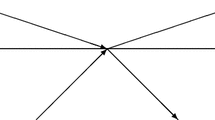Abstract
A large literature has grown up around the proposed use of ‘weak measurements’ (i.e., unsharp measurements followed by post-selection) to allegedly provide information about hidden ontological features of quantum systems. This paper attempts to clarify the fact that ‘weak measurements’ involve strong (projective) measurements on one (pointer) member of an entangled system. The only thing ‘weak’ about such measurements is that the correlation established via the entanglement does not correspond to eigenstates of the ‘weakly measured observable’ for the remaining component system(s) subject to the weak measurement. All observed statistics are straightforwardly and easily predicted by standard quantum mechanics. Specifically, it is noted that measurement of the pointer steers the remaining degree(s) of freedom into new states with new statistical properties—constituting a non-trivial (even if generally small) disturbance. In addition, standard quantum mechanics readily allows us to conditionalize on a final state if we choose, so the ‘post-selection’ that features prominently in time-symmetric formulations is also equipment from standard quantum theory. Assertions in the literature that weak measurements leave a system negligibly disturbed, and/or that standard quantum theory is cumbersome for computing the predicted measurement results, are therefore unsupportable, and ontological claims based on such assertions need to be critically reassessed.
Similar content being viewed by others
Notes
In this procedure, the ‘weak value’ is no more an ontological property of any individual system/pointer pair than an average height is for each member of a large group of people, although of course their heights collectively contribute to the average.
ACE use a continuous pointer basis, which simply means that there are infinitely many possible ‘error’ states for the pointer, within a given range. For the continuous pointer position basis \(\{X\}\), the entanglement would be set up through the evolution \(|{P_0 \rangle | {z+\rangle \rightarrow \mathop \smallint \nolimits dX \langle X|P+\rangle }|X}\rangle |z+\rangle \) and \(|{P_0 \rangle | {z-\rangle \rightarrow \mathop \smallint \nolimits dX \langle X|P-\rangle } |X} |z-\rangle \) . P is always detected in some position state \(|X\rangle \) which, due to the overlap of \(|P+\rangle \) and \(|P-\rangle \), cannot be clearly identified with either ‘up’ or ‘down’ on the part of the measured system. We use a discrete two-valued pointer basis here,\(\{|u,|d\}\), to clarify the basic concepts involved.
An improper mixed state for a component system is obtained by tracing out the degrees of freedom of its entangled partner. In general, it cannot be interpreted as a statistical mixture over unknown but ontologically applicable pure states of the system, hence the term ‘improper’.
For example, the Born Rule for the probabilities of measurement outcomes was arrived at via an educated guess by Max Born. Clearly this does not indicate that the Rule’s ontological significance has something to do with guessing.
Such considerations include the ambiguity of time order of the measurements on spacelike-separated systems. This issue raises interesting interpretive questions and will be considered in light of other time-symmetric interpretations in a separate work. But it does not in itself single out TSVF as the appropriate ontology. Also, the present author is aware that much more complicated experiments can and have been carried out, with entanglement of greater than two degrees of freedom. This does not affect the basic argument, which is that the behavior all such systems is exactly as predicted by standard quantum mechanics, and that one can always conditionalize on any final state of interest to make use of the more ‘elegant’ calculations advertised as a putative advantage of the TSVF formalism.
References
Busch, P., Grabowski, M., Lahti, P.: Operational Quantum Physics. Springer-Verlag, Berlin (1996)
Aharonov, Y., Cohen, E., Elitzur, A. (2015). Ann. Phys. 355 258-268. arXiv:1206.6224
Aharonov, Y., Albert, D.Z., Vaidman, L.: How the result of a measurement of a component of the spin of a spin-1/2 particle can turn out to be 100. Phys. Rev. Lett. 60(14), 1351–1354 (1988)
Aharonov, Y., Vaidman, L.: Properties of a quantum system during the time interval between two measurements. Phys. Rev. A 41, 11 (1990)
Aharonov, Y., Botero, A., Popescu, S., Reznik, B., Tollaksen, J.: Revisiting Hardy’s paradox: counterfactual statements, real measurements, entanglement and weak values. Phys. Lett. A 301, 130–138 (2002)
Bub, J.: Interpreting the Quantum World. Cambridge University Press, Cambridge (1997)
Vaidman, L.: Weak-measurement elements of reality. Found. Phys. 26, 895–906 (1996)
Acknowledgements
The author is grateful to Avshalom Elitzur and Eliahu Cohen for interesting and valuable discussions and correspondence.
Author information
Authors and Affiliations
Corresponding author
Rights and permissions
About this article
Cite this article
Kastner, R.E. Demystifying Weak Measurements. Found Phys 47, 697–707 (2017). https://doi.org/10.1007/s10701-017-0085-4
Received:
Accepted:
Published:
Issue Date:
DOI: https://doi.org/10.1007/s10701-017-0085-4



